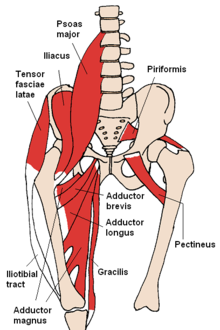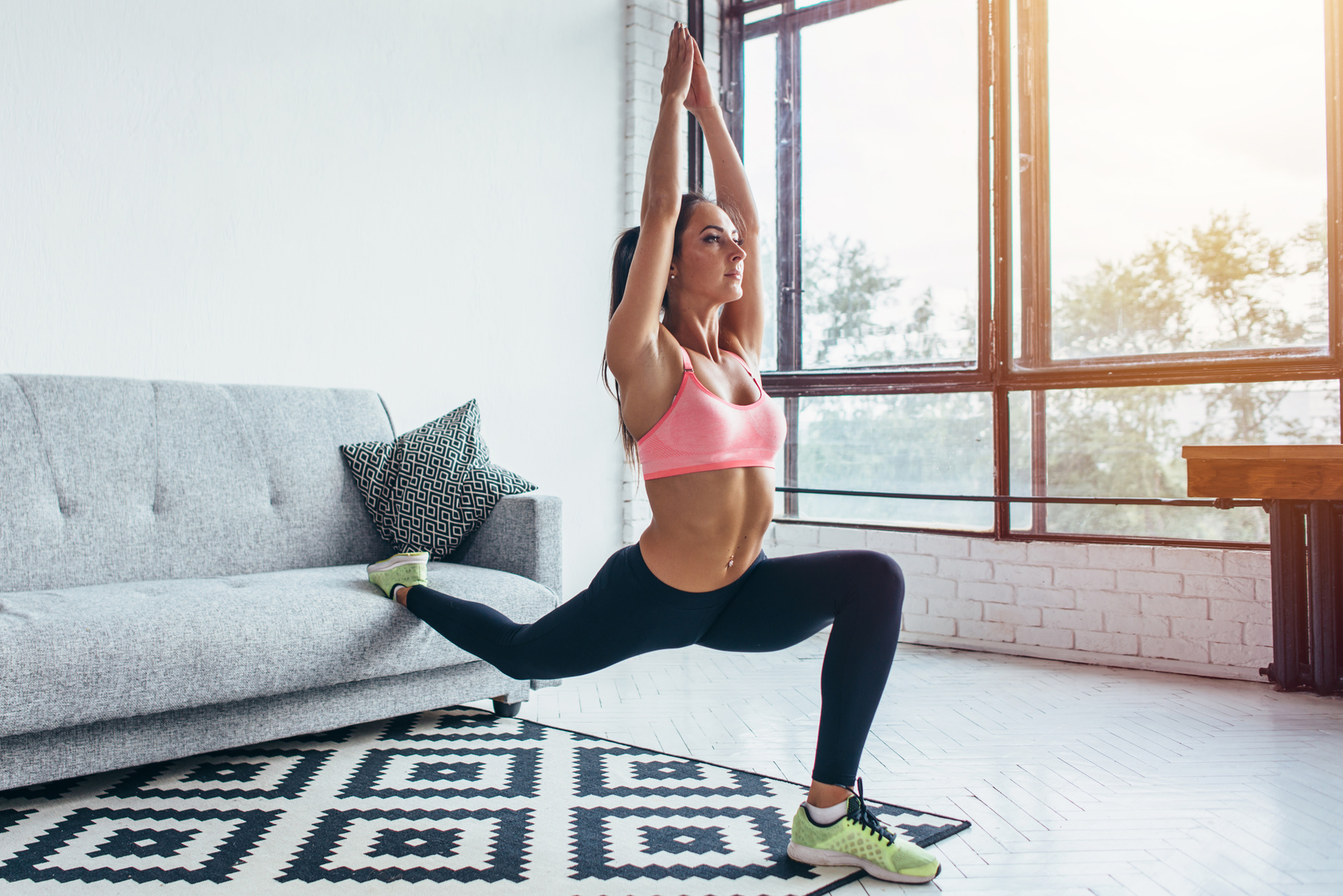Looking for some of the best hip stretches for runners?
You’re in the right place.
In today’s article I’ll show you how to stretch your hips in a safe and comfortable way. But first things first, let’s talk about why you need to add a few hip opening stretches to your training routine.
Let’s delve deeper…
*Disclosure: This post may contain affiliate links that at no additional cost to you. I only recommend products I’d use myself and all opinions expressed here are my own.
What Are The Hip Flexors?
Located near the top of your thighs, the hip flexors consist of a group of muscles and tendons on the front—anterior—of your hip joint, connecting your legs to your pelvis.
When contracted, your hip flexors let you raise your knees or bend at the hip.
The primary hip flexor muscles are the psoas major and the iliacus— collectively known as the iliopsoas, (usually the weakest of all of the muscles).
Other hip flexor muscles include the sartorius, tensor fascia latae, and rectus femoris.
See image.
And here’s how they look like :

Source – Wikipedia
The Functions Of the Hip Flexors
The hip flexor muscles are used in every stride when walking, running, and sprinting.
These allow you to walk, run, bend kick, and swivel your hips.
Your hip flexors are contracted on every step forward.
The more miles you log in, the more you put them to work.
Some of the main functions:
- Bringing the thighs up toward the chest.
- Driving the knees up and down.
- Maintaining proper running form.
- Moving the legs from side to side and front to back.
- Stabilizing the pelvis.
Causes of Hip Issues
The hips is just one region of the body that’s prone to tightness if you’re a runner.
Running’s repetitive nature means that you’re constantly working the hip flexors and extensors through a very small range of motion.
So it’s not surprising that hip pain from running is such a common issue.
Add to this the fact that, thanks to our sedentary lifestyle, we spend the bulk of our time sitting—roughly a third of the day.
When you spend a lot of time in a seated position, your hip flexors are kept in a shortened position more than they should be, which, in turn, makes them super tight.
This has huge negative effects on your posture, spinal stability, and gait.
Ramifications of Tightness
Tightness in the hip flexors results in an exaggerated anterior pelvic tilt.
This occurs when the arch of the lower back increases while the backside stick out more.
The tighter your hip flexors get, the more your pelvis tilts back and the more likely you’re to lean forward—as in stick out your butt and arch your back—while running.
Not only this is bad form, but can also set you up for back pain and serious injury. And you want none of that.
For more on the research conducted on hip muscle tightness and overuse injury, check the following studies:
Study 1
How To Test Your Hip Flexor Flexibility
Wondering if your hips are too tight—or loose enough? Take the Thomas test.
Also known as Iliacus test or Iliopsoas Test, this test is used to measure the flexibility of the hip flexors—more specifically, that of the iliopsoas muscle group, the pectineus, Rectus Femoris, gracillus as well as the Sartorius and Tensor Fascia.
Proper form
Start by laying or sitting at the very edge of a table or bent, with the tailbone resting at the edge.
Then, roll back onto the table while pulling both knees to your chest.
This helps ensure that your lumbar spine is flat on the table and your pelvis is posteriorly rotated.
Next, hold the opposite hip in maximum flexor with the arms, while the assessed limb hang down toward the floor.
Last up, perform on both sides and compare.
Results
If your left leg lower backs, and sacrum remain flat on the table with the knee bending to 70 to 90 degrees, kudos…you don’t have tight hip flexors.
However, if one of your thighs or legs stay up drastically higher than the other, then you do have tight hips, and regular hip openning stretches are required.
Now that you know a thing or two about the importance of hip stretches for runners, let’s get to the exercises themselves.
Top 7 Hip Stretches For Runners
Fortunately, there’s is an abundance of good hip openining stretches that you can perform at home to decrease tightness, relieve pain, and increase mobility in your hips.
You won’t need to join a gym, buy a lot of expensive equipment or even leave the comfort of your home to perform the following hip flexors exercises.
Enjoy!
Hip Stretch for Runner – 1. Pigeon
Also known as Eka pada rajakapotasana, this is a famous yoga pose, and one of the most effective hip flexors stretches, especially the hip abductors.
Proper Form
Begin by sitting with your right knee bent and left leg stretched behind you.
Next, while making sure that your left hip is always pointing toward the mat, drag your right heel toward your left hip.
Then rest your hands on your right thigh or your hips, then walk your hands out in front of you, and lower your hips down toward the floor over your right knee.
Hold the pose for 30 seconds to one minute.
Be sure to breathe into any area of discomfort or tension.
Repeat on the other side.
Hip Stretch for Runner – 2. Lunge Hip Flexor Stretch
One of the best best hip stretches for runners that not only targets most of the muscles in the hips, but it’s also ideal for stretching the glutes, hamstrings, and quadriceps.
Proper Form
Assume a lunge position with your right knee forward.
Next, drop your left knee to the ground, and place your hands on your right knee or the floor under your shoulders, according to your flexibility level.
Be sure to keep your upper body tall, and core engaged the entire time.
Then, while keeping your front knee directly above your ankle, hold the position for 30 seconds to one minute, and feel the stretch in your left hip flexor.
Change sides and repeat.
Hip Stretch for Runner – 3. Happy Baby
Also known as Ananda Balasana in the yogic circles, this relaxing hip stretch also targets the lower back and the hamstrings.
Proper Form
Lay flat on your back with both knees bent while gently holding the outside edges of your feet with your hands.
Next, while keeping your arms on the outside of your legs, press both knees to the ground below your armpits.
Feel free to rock lightly from side to side if that feels good.
Hold the pose for at least one minute, then move to the next stretch.
Hip Stretch for Runner – 4. Butterfly
A powerful hip opener that also stretches the glutes and the inner thighs.
Proper Form
Assume a cross-legged seated position with the soles of the feet pressed together.
Next, while grabbing your ankles, lengthen your spine upward, draw your belly button inward then slowly fold forward from your hips with a deep exhale.
Focus on your inner thighs and be sure to breathe into that area to release any tension or discomfort.
For more stretch, feel free to crawl your hands forward away from your body.
Hold the pose for one minute then slowly release and move to the next stretch.
Hip Stretch for Runner – 5. Extended Wide Squat
Not only this hip opening stretch is ideal for the hip abductors, but also increase mobility in the lower back, hamstrings, and glutes.
Proper Form
Assume a standing position, with the feet slightly wider than your hips, toes pointing out so that hips are open.
Next, while keeping your back flat and core engaged, slowly bend your knees and lower your hips toward the floor.
For more stretch, place your elbows inside of your thighs, gently pressing them out against the inside of your knees.
Hold the pose for 30 seconds to one minute then slowly release back to standing position.
Hip Stretch for Runner – 6. Frog Hip Stretch
This simple pose stretches and opens up the the hip abductors, the insides of the thighs, and the groin.
If you have any recent leg, hip or knee injury, be careful with this one.
Proper Form
This is one of my favorite hip flexor stretches.
Assume an all fours position with hands and knee in a tabletop position, then bring your forearms onto the mat or a yoga block.
Next, slowly slide both knees away from your body and widen them out as far as possible as you lower your chest and hips toward the floor.
Hold the position for one to two minutes then slowly release it and move to the next stretch.
Hip Stretch for Runner – 7. Standing Wide-Legged Split
This stretch will not only target your hips but also opens up your inner thighs and hamstrings.
Proper Form
Begin by sitting up tall with the feet three to four feet apart, heels a bit wider than the toes.
Next, while keeping the soles of your feet flat on the floor and torso long, fold forward from the hips and place your hands on a yoga block or mat right below your shoulders.
Hold the pose for 30 seconds to one minute.
If your flexibility allows it, feel free to lower onto forearms for a deeper hips stretch.
New to Running? Start Here…
If you’re serious about running, getting fit, and staying injury free, then make sure to download my Runners Blueprint Guide!
Inside this guide, you’ll learn how to start running and lose weight weight the easy and painless way. This is, in fact, your ultimate manifesto to becoming a faster and a stronger runner. And you want that, don’t you?
Click HERE to check out my Runners Blueprint System today!
Don’t miss out! My awesome running plan is just one click away.
Top 7 Hip Stretches For Runners – The Conclusion
There you have it!
The above hip flexor stretches for runners are all you need for to open your hip flexors and keep flexible for the long haul.
Just make sure to do them on a regular basis. The rest is just detail.



